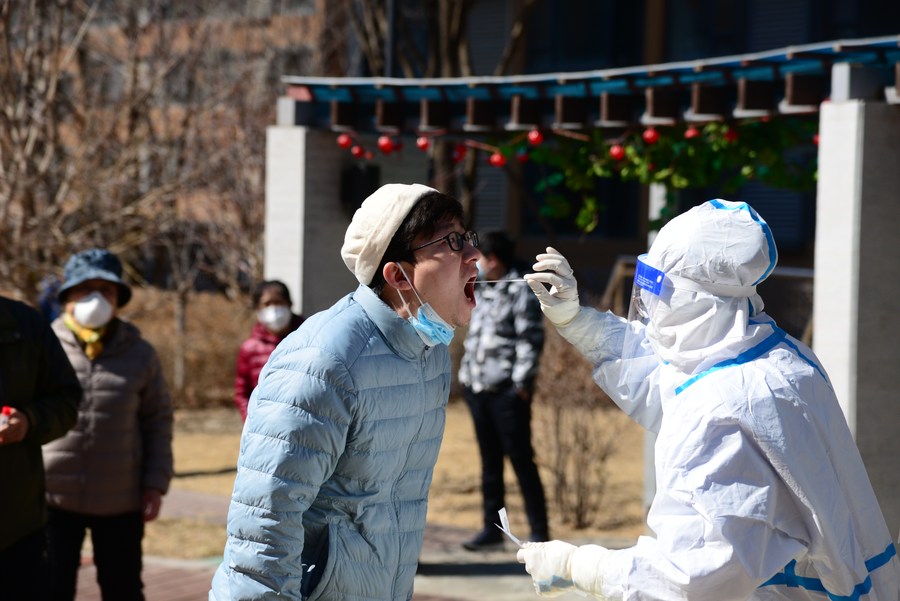In-depth explainer of China's dynamic zero-COVID policy
* While some shops, malls, factories and tourist sites were shut down in Shanghai, thousands of companies maintain operation.
* Based on more than two years of epidemic control experience, the dynamic zero-COVID policy has proved effective in China's fight against the virus, and it will continue to guide the country's epidemic control and prevention efforts.
* China puts the people and human life above anything else in the fight against the epidemic, and this guiding principle determines that a laissez-faire control approach is never an option.
* About 90 percent of China's total population had been fully vaccinated against COVID-19.
BEIJING, April 2 (Xinhua) -- In the spring of 2022, China faces grave challenges in its battle against COVID-19. The country is still working tirelessly to fully contain the spread of the virus in the current wave of the epidemic.
Shanghai, China's financial hub and a metropolis with a population of over 24 million, has entered temporary closed-off management as the city saw the number of infections growing by thousands each day in the last few days.

Aerial photo taken on the early morning of April 1, 2022 shows areas west of the Huangpu River in east China's Shanghai. (Photo by Yang Fan/Xinhua)
While some shops, malls, factories and tourist sites were shut down, thousands of companies including many foreign businesses maintain their operations. Also, the city's financial institutions remained open, helping the country's stock and bond markets continue to operate undisrupted. This is largely due to the confidence they have in the country's epidemic control policy.
Indeed, the new epidemic waves puts the country's dynamic zero-COVID policy to the test. Based on more than two years of epidemic control experience, this policy has proved effective in China's fight against the virus. In the days to come, it will continue to guide the country's epidemic control and prevention efforts.
In the face of more complicated and pressing challenges, China has the knowledge, determination, and ability to bring epidemic waves under control.
READY TO MEET CHALLENGES
According to Ma Xiaowei, head of China's National Health Commission, the dynamic zero-COVID policy's main features comprises swiftness and accuracy, and aims to contain epidemic flare-ups through timely actions. It integrates a series of measures covering all aspects of epidemic control -- from case detection and tracing to quarantine and treatment.

Residents queue to take nucleic acid tests at a community in Hongkou District of east China's Shanghai, April 1, 2022. (Photo by Yang Fan/Xinhua)
In two years' time, the country spared no effort to detect infections, report them, quarantine cases, and get them treated as quickly as possible. In the meantime, it has been improving its targeted epidemic control measures constantly.
These measures, coupled with China's epidemic prevention focus to guard against both inbound cases and domestic resurgence, enable China to restrict the spread of the virus and minimize the epidemic's impact.
The effectiveness of the policy and China's capability to implement it have been tested. According to leading epidemiologist Liang Wannian, since April 2020, the sporadic cases and regional clusters reported in China have largely come from abroad. It indicates that the country has effectively stopped infections from domestic sources.
"This favorable condition lays a solid foundation for China to continue pursuing the dynamic zero-COVID policy, as the source of every infection can be identified," said Liang.
WILLING TO PROTECT PEOPLE'S LIVES
China didn't choose to pursue this seemingly demanding policy for no reason. In its fight against the epidemic, the country puts the people and human life above anything else. This guiding principle determines that a laissez-faire control approach is never an option.
China has a large population of 1.4 billion and is home to 267 million elderly and more than 250 million minors, who are more vulnerable to the virus. Given this situation, containing the virus as early as possible is crucial for the country to safeguard the people's well-being.
This is why the dynamic zero-COVID policy attaches equal importance to prevention and treatment, for China cannot afford to leave the virus on the loose. Ma warned that should China give up on epidemic prevention and rely entirely on treatment of symptoms, the country's medical system would be stretched too thin.
For more than two years, China persistently adopted active epidemic prevention measures like early detection and quarantine of infections and launched mass vaccination. Currently, in the face of the more infectious Omicron variant, the country shows no slackness or hesitation in pursuing its dynamic zero-COVID policy, for its determination to ensure the health and well-being of its people remains the same.
ABLE TO MINIMIZE IMPACT
During its fight against the virus, China has been accumulating much epidemic control experience, and has significantly improved its ability to implement the policy. Today, the country conducts epidemic prevention and control measures efficiently and effectively, boosting its capacity to implement the dynamic zero-COVID policy.
In conducting nucleic acid tests, the first line of defense in epidemic containment, China can now finish mass tests in large cities with more than 10 million people within 24 hours. The country has also improved its targeted quarantine policies and can implement differentiated measures based on each region's risk level to best suit local conditions.
What also facilitates the policy's implementation is the great synergy between all parties involved in epidemic control.

A medical worker takes a swab sample from a resident for nucleic acid test at a COVID-19 testing site in Changchun, northeast China's Jilin Province, March 30, 2022. (Xinhua/Zhang Jian)
Coordinated actions take place throughout society whenever and wherever an outbreak occurs. While the authorities quickly formulate countermeasures, medical personnel are working tirelessly to treat patients, and community workers take up their due responsibilities to ensure the livelihood of residents and see to it epidemic prevention measures are implemented.
The public supports the country's efforts by actively observing epidemic control requirements. As of March 31, 1.24 billion people, or about 90 percent of the country's total population, had been fully vaccinated against COVID-19. Also, about 213 million of China's elderly citizens aged above 60 had been fully vaccinated.
Indeed, as the Chinese leadership once said, China's epidemic control manifests the socialist system's ability to pool strength behind significant undertakings and the solidarity of the Chinese people.
With outbreaks contained in time, China resumed its economic and social development. In 2021, its economy grew by 8.1 percent, while its total trade in goods exceeded 6 trillion U.S. dollars for the first time.
Currently, the pandemic is still raging across the world. But no matter the hardships, China will continue to implement and develop its dynamic zero-COVID policy to remain ready, willing, and able to defend itself and its people against the virus.
Photos
Related Stories
- COVID-19 vaccination bill reaches 120 bln yuan in China
- New study suggests cardiac complications risk higher after COVID-19 infection than after mRNA vaccination
- Ruijin Hospital optimizing emergency services in Shanghai
- Shanghai screens over 14 mln people in 2nd phase of closed-off management
- China plans to boost TCM role in infectious disease treatment
- Farm produce providers in Shanghai ensure supply of vegetables for residents under closed-off management
- Shanghai's largest temporary quarantine site operational
- Chinese mainland reports 2,086 new local COVID-19 cases
- COVID-19 transmission in Shanghai at rapidly rising stage: spokesperson
- China must adhere to dynamic zero-COVID approach: health expert
Copyright © 2022 People's Daily Online. All Rights Reserved.










